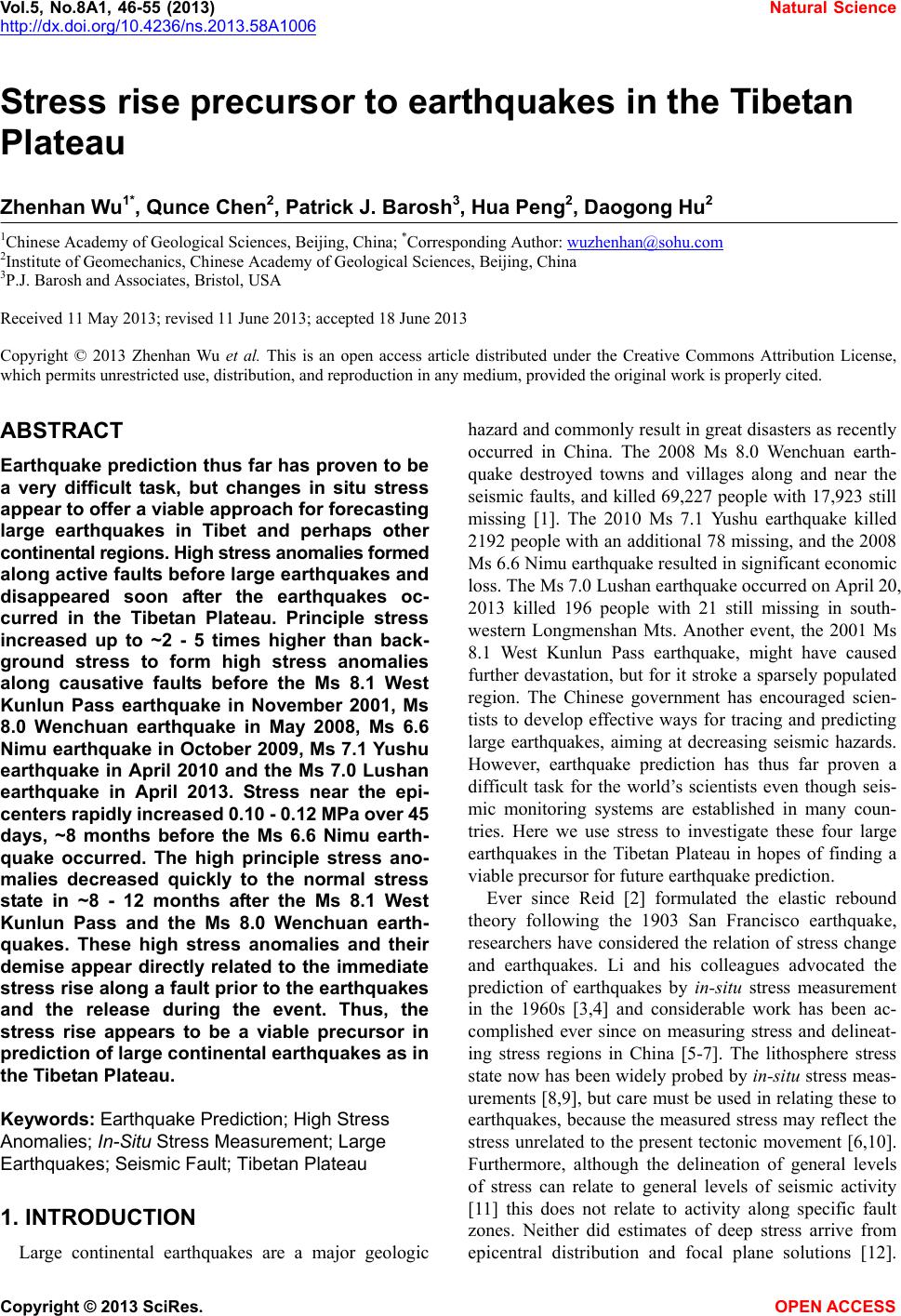 Vol.5, No.8A1, 46-55 (2013) Natural Science http://dx.doi.org/10.4236/ns.2013.58A1006 Stress rise precursor to earthquakes in the Tibetan Plateau Zhenhan Wu1*, Qunce Chen2, Patrick J. Barosh3, Hua Peng2, Daogong Hu2 1Chinese Academy of Geological Sciences, Beijing, China; *Corresponding Author: wuzhenhan@sohu.com 2Institute of Geomechanics, Chinese Academy of Geological Sciences, Beijing, China 3P.J. Barosh and Associates, Bristol, USA Received 11 May 2013; revised 11 June 2013; accepted 18 June 2013 Copyright © 2013 Zhenhan Wu et al. This is an open access article distributed under the Creative Commons Attribution License, which permits unrestricted use, distribution, and reproduction in any medium, provided the original work is properly cited. ABSTRACT Earthquake prediction thus far has proven to be a very difficult task, but changes in situ stress appear to offer a viable approach for forecasting large earthquakes in Tibet and perhaps other continent al regions. High stress anom alies formed along active faults before large earthquakes and disappeared soon after the earthquakes oc- curred in the Tibetan Plateau. Principle stress increased up to ~2 - 5 times higher than back- ground stress to form high stress anomalies along causative faults before the Ms 8.1 West Kunlun Pass earthquake in November 2001, Ms 8.0 Wenchuan earthquake in May 2008, Ms 6.6 Nimu earthquake in October 2009, Ms 7.1 Yushu earthquake in April 2010 and the Ms 7.0 Lushan earthquake in April 2013. Stress near the epi- centers rapidly increased 0.1 0 - 0.12 MPa ov er 45 days, ~8 months before the Ms 6.6 Nimu earth- quake occurred. The high principle stress ano- malies decreased quickly to the normal stress state in ~8 - 12 months after the Ms 8.1 West Kunlun Pass and the Ms 8.0 Wenchuan earth- quakes. These high stress anomalies and their demise appear directly related to the immediate stress rise along a fault prior to the earthquakes and the release during the event. Thus, the stress rise appears to be a viable precursor in prediction of large continental earthquakes as in the Tibetan Plateau. Keywords: Earthquake Prediction; High Stress Anomalies; In-Situ Stress Measurement; Large Earthquakes; Seismic Faul t; Tibetan Plateau 1. INTRODUCTION Large continental earthquakes are a major geologic hazard and commonly result in great disasters as recently occurred in China. The 2008 Ms 8.0 Wenchuan earth- quake destroyed towns and villages along and near the seismic faults, and killed 69,227 people with 17,923 still missing [1]. The 2010 Ms 7.1 Yushu earthquake killed 2192 people with an add itional 78 missing, and the 2008 Ms 6.6 Nimu earthquake resulted in significant economic loss. The Ms 7.0 Lushan earthquake occurred on April 20, 2013 killed 196 people with 21 still missing in south- western Longmenshan Mts. Another event, the 2001 Ms 8.1 West Kunlun Pass earthquake, might have caused further devastation, but for it stroke a sparsely populated region. The Chinese government has encouraged scien- tists to develop effective ways for tracing and predicting large earthquakes, aiming at decreasing seismic hazards. However, earthquake prediction has thus far proven a difficult task for the world’s scientists even though seis- mic monitoring systems are established in many coun- tries. Here we use stress to investigate these four large earthquakes in the Tibetan Plateau in hopes of finding a viable precursor for future earthquake prediction. Ever since Reid [2] formulated the elastic rebound theory following the 1903 San Francisco earthquake, researchers have considered the relation of stress change and earthquakes. Li and his colleagues advocated the prediction of earthquakes by in-situ stress measurement in the 1960s [3,4] and considerable work has been ac- complished ever since on measuring stress and delineat- ing stress regions in China [5-7]. The lithosphere stress state now has been widely probed by in-situ stress meas- urements [8,9], but care must be used in relating these to earthquakes, because the measured stress may reflect the stress unrelated to the present tectonic movement [6,10]. Furthermore, although the delineation of general levels of stress can relate to general levels of seismic activity [11] this does not relate to activity along specific fault zones. Neither did estimates of deep stress arrive from epicentral distribution and focal plane solutions [12]. Copyright © 2013 SciRes. OPEN A CCESS 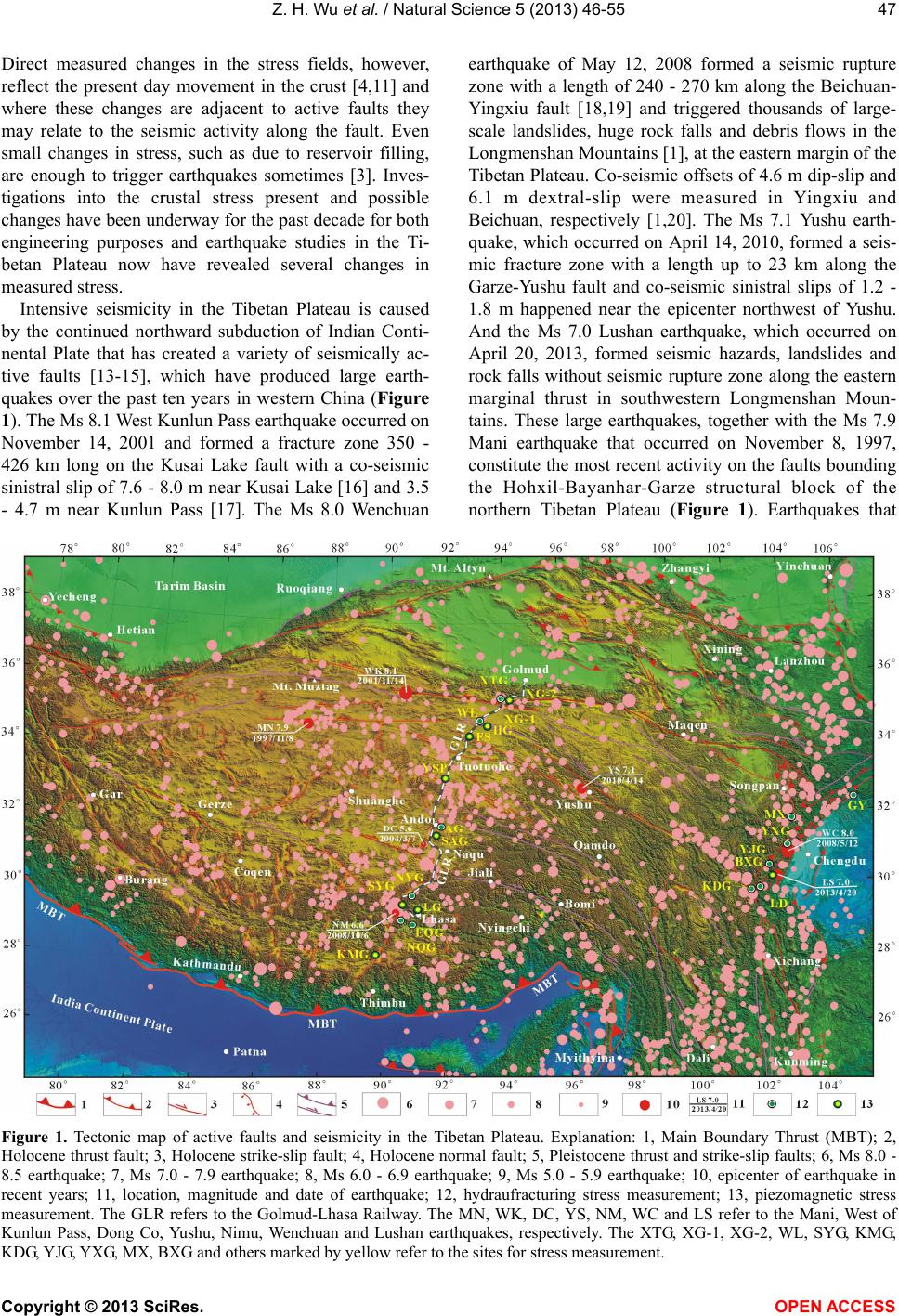 Z. H. Wu et al. / Natural Science 5 (2013) 46-55 47 Direct measured changes in the stress fields, however, reflect the present day movement in the crust [4,11] and where these changes are adjacent to active faults they may relate to the seismic activity along the fault. Even small changes in stress, such as due to reservoir filling, are enough to trigger earthquakes sometimes [3]. Inves- tigations into the crustal stress present and possible changes have been underway for the past decade for both engineering purposes and earthquake studies in the Ti- betan Plateau now have revealed several changes in measured stress. Intensive seismicity in the Tibetan Plateau is caused by the continued northward subduction of Indian Conti- nental Plate that has created a variety of seismically ac- tive faults [13-15], which have produced large earth- quakes over the past ten years in western China (Figure 1). The Ms 8.1 West Kunlun Pass earthquake occurred on November 14, 2001 and formed a fracture zone 350 - 426 km long on the Kusai Lake fault with a co-seismic sinistral slip of 7.6 - 8.0 m near Kusai Lake [16] and 3.5 - 4.7 m near Kunlun Pass [17]. The Ms 8.0 Wenchuan earthquake of May 12, 2008 formed a seismic rupture zone with a length of 240 - 270 km along the Beichuan- Yingxiu fault [18,19] and triggered thousands of large- scale landslides, huge rock falls and debris flows in the Longmenshan Moun tain s [1], at th e eastern margin of the Tibetan Plateau. Co-seismic offsets of 4.6 m dip-slip and 6.1 m dextral-slip were measured in Yingxiu and Beichuan, respectively [1,20]. The Ms 7.1 Yushu earth- quake, which occurred on April 14, 2010, formed a seis- mic fracture zone with a length up to 23 km along the Garze-Yushu fault and co-seismic sinistral slips of 1.2 - 1.8 m happened near the epicenter northwest of Yushu. And the Ms 7.0 Lushan earthquake, which occurred on April 20, 2013, formed seismic hazards, landslides and rock falls without seismic rupture zone along the eastern marginal thrust in southwestern Longmenshan Moun- tains. These large earthquakes, together with the Ms 7.9 Mani earthquake that occurred on November 8, 1997, constitute the most recent activity on the faults bounding the Hohxil-Bayanhar-Garze structural block of the northern Tibetan Plateau (Figure 1). Earthquakes that Figure 1. Tectonic map of active faults and seismicity in the Tibetan Plateau. Explanation: 1, Main Boundary Thrust (MBT); 2, Holocene thrust fault; 3, Holocene strike-slip fault; 4, Holocene normal fault; 5, Pleistocene thrust and strike-slip faults; 6, Ms 8.0 - 8.5 earthquake; 7, Ms 7.0 - 7.9 earthquake; 8, Ms 6.0 - 6.9 earthquake; 9, Ms 5.0 - 5.9 earthquake; 10, epicenter of earthquake in recent years; 11, location, magnitude and date of earthquake; 12, hydraufracturing stress measurement; 13, piezomagnetic stress measurement. The GLR refers to the Golmud-Lhasa Railway. The MN, WK, DC, YS, NM, WC and LS refer to the Mani, West of Kunlun Pass, Dong Co, Yushu, Nimu, Wenchuan and Lushan earthquakes, respectively. The XTG, XG-1, XG-2, WL, SYG, KMG, KDG, YJG, YXG, MX, BXG and others marked by yellow refer to the sites for stress measurement. Copyright © 2013 SciRes. OPEN A CCESS 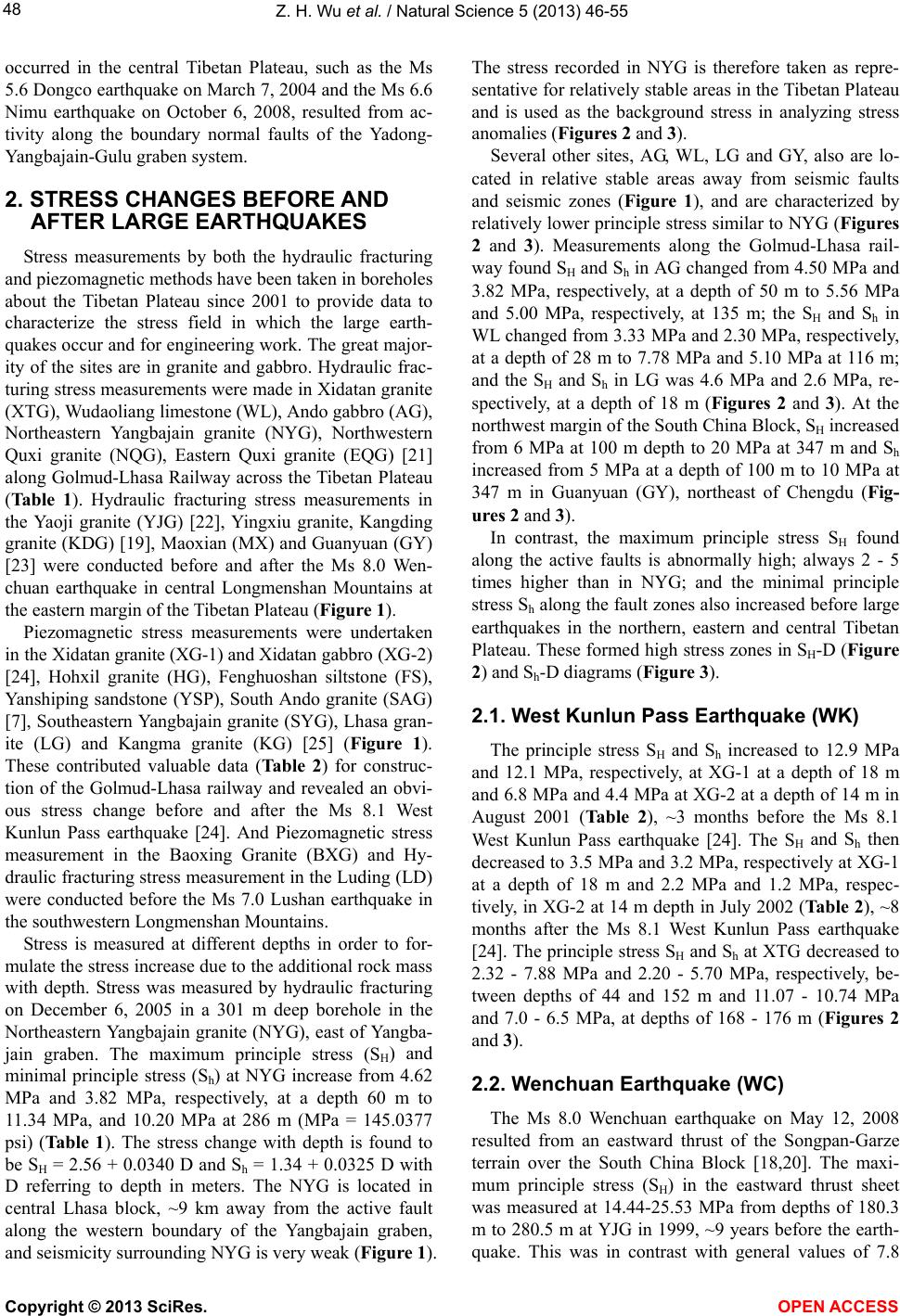 Z. H. Wu et al. / Natural Science 5 (2013) 46-55 48 occurred in the central Tibetan Plateau, such as the Ms 5.6 Dongco earthquake on March 7, 2004 and the Ms 6.6 Nimu earthquake on October 6, 2008, resulted from ac- tivity along the boundary normal faults of the Yadong- Yangbajain-Gulu graben system. 2. STRESS CHANGES BEFORE AND AFTER LARGE EARTHQUAKES Stress measurements by both the hydraulic fracturing and piezomagnetic methods have been taken in boreholes about the Tibetan Plateau since 2001 to provide data to characterize the stress field in which the large earth- quakes occur and for engineering work. The great major- ity of the sites are in granite and gabbro. Hydraulic frac- turing stress measurements were made in Xidatan granite (XTG), Wudaoliang limestone (WL), And o g a bb r o (AG ), Northeastern Yangbajain granite (NYG), Northwestern Quxi granite (NQG), Eastern Quxi granite (EQG) [21] along Golmud-Lhasa Railway across the Tibetan Plateau (Table 1). Hydraulic fracturing stress measurements in the Yaoji granite (YJG) [22], Yingxiu granite, Kangding granite (KDG ) [19], Maoxian (MX) an d Guanyuan (GY) [23] were conducted before and after the Ms 8.0 Wen- chuan earthquake in central Longmenshan Mountains at the eastern margin of the Tibetan Plateau (Figure 1). Piezomagnetic stress measurements were undertaken in t he X idatan granite (XG-1) and Xidatan gab bro (XG -2 ) [24], Hohxil granite (HG), Fenghuoshan siltstone (FS), Yanshiping sandstone (YSP), South Ando granite (SAG) [7], Southeastern Yangbajain granite (SYG), Lhasa gran- ite (LG) and Kangma granite (KG) [25] (Figure 1). These contributed valuable data (Table 2) for construc- tion of the Golmud-Lhasa railway and revealed an obvi- ous stress change before and after the Ms 8.1 West Kunlun Pass earthquake [24]. And Piezomagnetic stress measurement in the Baoxing Granite (BXG) and Hy- draulic fracturing stress measurement in the Luding (LD) were conducted before the Ms 7.0 Lushan earthquake in the southwestern Longmenshan Mountains. Stress is measured at different depths in order to for- mulate the stress increase due to the additional ro ck mass with depth. Stress was measured by hydraulic fracturing on December 6, 2005 in a 301 m deep borehole in the Northeastern Yangbajain granite (NYG), east of Yangba- jain graben. The maximum principle stress (SH) and minimal principle stress (Sh) at NYG increase from 4.62 MPa and 3.82 MPa, respectively, at a depth 60 m to 11.34 MPa, and 10.20 MPa at 286 m (MPa = 145.0377 psi) (Ta b le 1). The stress change with depth is found to be SH = 2.56 + 0.0340 D and Sh = 1.34 + 0.0325 D with D referring to depth in meters. The NYG is located in central Lhasa block, ~9 km away from the active fault along the western boundary of the Yangbajain graben, and seismicity surrounding NYG is very weak (Figure 1). The stress recorded in NYG is therefore taken as repre- sentative for relatively stable areas in the Tibetan Plateau and is used as the background stress in analyzing stress anomalies (Figures 2 and 3). Several other sites, AG, WL, LG and GY, also are lo- cated in relative stable areas away from seismic faults and seismic zones (Figure 1), and are characterized by relatively lower principle stress similar to NYG (Figures 2 and 3). Measurements along the Golmud-Lhasa rail- way found S H and Sh in AG changed from 4.50 MPa and 3.82 MPa, respectively, at a depth of 50 m to 5.56 MPa and 5.00 MPa, respectively, at 135 m; the SH and Sh in WL changed from 3.33 MPa and 2.30 MPa, respectively, at a depth of 28 m to 7.78 MPa and 5.10 MPa at 116 m; and the SH and Sh in LG was 4.6 MPa and 2.6 MPa, re- spectively, at a depth of 18 m (Figures 2 and 3). At the northwest margin of the South China Block, SH increased from 6 MPa at 100 m depth to 20 MPa at 347 m and Sh increased from 5 MPa at a depth of 100 m to 10 MPa at 347 m in Guanyuan (GY), northeast of Chengdu (Fig- ures 2 and 3). In contrast, the maximum principle stress SH found along the active faults is abnormally high; always 2 - 5 times higher than in NYG; and the minimal principle stress Sh along the fault zones also increased before large earthquakes in the northern, eastern and central Tibetan Plateau. These formed high stress zones in SH-D (Figure 2) and Sh-D diagrams (Figure 3). 2.1. West Kunlun Pass Earthquake (WK) The principle stress SH and Sh increased to 12.9 MPa and 12.1 MPa, respectively, at XG-1 at a depth of 18 m and 6.8 MPa and 4.4 MPa at XG-2 at a depth of 14 m in August 2001 (Table 2), ~3 months before the Ms 8.1 West Kunlun Pass earthquake [24]. The SH and Sh then decreased to 3.5 MPa and 3.2 MPa, respectively at XG-1 at a depth of 18 m and 2.2 MPa and 1.2 MPa, respec- tively, in XG-2 at 14 m depth in July 2002 (Table 2), ~8 months after the Ms 8.1 West Kunlun Pass earthquake [24]. The principle stress SH and Sh at XTG decreased to 2.32 - 7.88 MPa and 2.20 - 5.70 MPa, respectively, be- tween depths of 44 and 152 m and 11.07 - 10.74 MPa and 7.0 - 6.5 MPa, at depths of 168 - 176 m (Figures 2 and 3). 2.2. Wenchuan Earthquake (WC) The Ms 8.0 Wenchuan earthquake on May 12, 2008 resulted from an eastward thrust of the Songpan-Garze terrain over the South China Block [18,20]. The maxi- mum principle stress (SH) in the eastward thrust sheet was measured at 14.44-25.53 MPa from depths of 180.3 m to 280.5 m at YJG in 1999, ~9 years before the earth- quake. This was in contrast with general values of 7.8 Copyright © 2013 SciRes. OPEN A CCESS  Z. H. Wu et al. / Natural Science 5 (2013) 46-55 49 Table 1. Stress measured by hydraulic fracturing in the Tibetan Plateau. Hydraulic fracturing parameters (MPa) Stress (MPa) Site and rock/date measured Depth (m) Pb Pr Ps Po T SH S h S v Orientation of SH 44.0 5.92 4.25 2.20 0.03 1.67 2.32 2.20 1.15 N21˚E 64.0 7.66 4.03 2.30 0.23 3.63 2.64 2.30 1.67 84.0 8.92 6.40 3.50 0.44 2.52 3.66 3.50 2.20 N29˚E 126.0 7.40 7.03 5.20 0.86 0.37 7.71 5.20 3.29 152.0 10.29 8.10 5.70 1.12 2.18 7.88 5.70 3.98 N43˚E 168.0 9.36 8.66 7.00 1.27 0.70 11.07 7.00 4.38 N34˚E Xidatan granite (XTG)/August, 2005 176.0 8.70 7.40 6.50 1.36 1.30 10.74 6.50 4.59 N42˚E 50.0 7.97 6.24 3.82 0.50 1.73 4.72 3.82 1.50 65.0 8.03 6.30 3.82 0.66 1.73 4.50 3.82 1.98 N10˚W 93.0 8.67 7.01 4.82 0.93 1.66 6.52 4.82 2.79 129.0 9.45 8.10 5.14 1.29 1.35 6.03 5.14 3.88 N9˚W Wudaoliang limestone (WL)/August, 2006 135.0 10.01 8.08 5.00 1.36 1.93 5.56 5.00 4.07 28.0 4.74 3.40 2.30 0.16 1.33 3.33 2.30 0.79 N11˚W 55.0 6.13 3.22 2.20 0.43 2.90 2.94 2.20 1.55 75.0 7.13 5.12 3.60 0.63 2.01 5.05 3.60 2.11 N24˚W 91.0 5.92 5.62 4.00 0.79 0.30 5.58 4.00 2.56 Ando gabbro (AG)/October, 2005 116.0 8.23 6.48 5.10 1.04 1.75 7.78 5.10 3.26 N13˚W 60.0 7.97 6.24 3.82 0.60 1.73 4.62 3.82 1.81 85.0 8.13 6.30 3.82 0.86 1.83 4.30 3.82 2.57 N55˚E 113.0 8.87 7.31 4.82 1.14 1.56 6.02 4.82 3.41 139.0 10.25 9.10 6.14 1.40 1.15 7.92 6.14 4.19 165.0 11.31 10.08 6.16 1.66 1.23 6.75 6.16 4.97 N46˚E 209.0 14.20 12.41 8.39 2.09 1.79 10.67 8.39 6.27 222.0 14.40 12.30 8.10 2.23 2.10 9.77 8.10 6.68 243.0 16.60 14.10 9.20 2.44 2.50 11.06 9.20 7.31 261.0 18.30 16.90 10.8 2.62 1.40 12.88 10.80 7.85 N65˚E Northeastern Yangbajain granite (NYG)/December, 2005 286.0 18.73 16.40 10.2 2.86 2.33 11.34 10.20 8.59 N53˚E 73.8 16.84 13.34 8.54 0.54 3.50 11.73 8.54 1.96 115.8 23.58 11.76 9.03 0.96 11.82 14.36 9.03 3.07 N46.5W 122.3 16.18 10.72 8.63 1.03 5.46 14.15 8.63 3.24 N39.6W Northwestern Quxi granite (NQG)/July, 2007 134.8 18.52 9.72 7.65 1.15 8.80 12.07 7.65 3.57 133.0 25.43 6.84 5.75 0.90 18.60 9.51 5.75 3.60 170.0 - 6.12 6.80 1.27 - 13.01 6.80 4.60 241.0 24.10 12.60 10.90 1.98 11.50 18.12 10.90 6.50 N3.0˚E 283.0 16.43 11.00 10.31 2.40 5.43 17.53 10.31 7.60 Eastern Quxi gr a nite (EQG)/After Cao et al., 2003 [21] 296.0 24.80 11.12 9.08 2.53 13.60 13.59 9.08 8.00 180.3 9.04 8.34 8.28 1.08 0.7 15.42 8.28 4.77 187.6 12.72 8.95 8.19 1.15 3.77 14.44 8.19 4.96 N57˚E 224.4 14.23 12.46 11.61 1.51 1.77 20.86 11.61 5.49 N63˚E 233.3 16.69 13.66 11.11 1.60 3.03 18.07 11.11 6.18 N1˚W 250.3 12.29 10.89 10.80 1.77 1.40 19.74 10.80 6.63 N55˚E 259.1 13.69 11.81 11.68 1.85 1.88 21.38 11.68 6.86 Yaoji granite (YJG)/after Mao et al., 1999 [22] 280.5 15.60 13.00 13.5 3 2.06 2.60 25.53 13.53 7.42 Copyright © 2013 SciRes. OPEN A CCESS  Z. H. Wu et al. / Natural Science 5 (2013) 46-55 50 Continued 90.0 4.30 3.50 2.60 0.82 0.80 3.48 2.60 2.39 128.0 13.62 12.78 7.44 1.20 0.84 8.34 7.44 3.39 142.0 9.95 8.70 5.95 1.34 1.25 7.81 5.95 3.76 N56˚W 171.0 18.21 18.18 11.81 1.63 0.03 15.62 11.81 4.53 Yingxiu granite (YXG)/after Wu et al., 2009 [19] 185.0 12.73 10.17 8.35 1.77 2.56 13.11 8.35 4.90 55.0 4.47 3.27 1.70 0.31 1.20 1.74 1.70 1.46 N5˚E 81.0 4.66 3.91 2.44 0.57 0.75 2.84 2.44 2.15 N81˚E 94.0 4.10 3.61 2.52 0.70 0.49 3.25 2.52 2.49 117.0 5.03 3.93 2.31 0.93 1.10 2.46 2.42 3.10 136.0 9.81 6.12 3.55 1.12 3.69 3.67 3.55 3.60 172.0 17.32 11.47 5.92 1.48 5.85 6.41 6.12 4.56 Kangding granite (KDG)/after Wu et al., 2009 [19] 186.0 10.91 6.89 4.94 1.62 4.02 6.31 4.94 4.93 Luding (LD) 150.0 16.00 10.00 4.00 N60˚W Maoxian (MX) 229.0 14.00 8.00 6.00 N55˚W 100.0 6.00 5.00 2.65 N30˚W 200.0 7.50 7.00 5.30 N35˚W Guanyuan (GY)/after An et al., 2004 [23] 347.0 20.00 10.00 9.20 Explanation: Pb, break down pressure; Pr, re-opening pressure; Ps, shut-in pressure; Po: pore pressure; T, tensor strength; SH, horizontal maximum principle stress; Sh, horizontal minimal principle stress; Sv, vertical stress caused by overloading rocks with density 2.63 (g/cm3), 2.70 (g/cm3) or 3.02 (g/cm3). Stress of LD, MX and GY came from An et al., 2004 [23]. Sites of measured stress are marked by yellow in Figure 1. MPa at depths of 170 m found to the northwest [6]. The stress then had decreased to 3.48 - 8.34 MPa between depths of 90 m to 142 m at YXG and 1.74 - 6.41 MPa from depths of 55 m to 186 m at KDG in 2009 (Figure 2), one year after the Wenchuan earthquake. The minimal principle stress (Sh) also changed from high anomaly at YJG before the Wenchuan earthquake to normal in YXG at depths of 90 - 142 m and in KDG at depths of 55 - 186 m after the earthquake (Figure 3). The principle stress still remained at higher values at greater depths. The SH and Sh was 13.11 - 15.62 MPa and 11.81 - 8.35 MPa, respectively, at depths of 171 - 185 m in Yingxiu (YXG) along the seismic Beichuan-Yingxiu fault one year after the Wenchuan earthquake (Ta bles 1 and 2). High princi- ple stress also occurred in Maoxian (MX) along the seismic Beichuan-Yingxiu fault, and the SH and Sh were 14 MPa and 8 MPa, respectively, in MX at a depth of 229 m (Tab l e 1 ). However, the stress had remained low with SH, 6 - 7.5 MPa, and Sh, 5.0 - 7.0 MPa in GY at depths of 100-200 m in the stable South China Block [23], ~4 years before the Wenchuan earthquake. 2.3. Dongco Earthquake (DC) The Ms 5.6 Dongco earthquake, which was due to normal fault offset in the Yadong-Yangbajain-Gulu gra- ben system, was preceded by a high stress anomaly in the South Ando granite (SAG) (Figures 2 and 3). Principle stress SH and Sh reached 8.1 MPa and 4.8 MPa, respec- tively, in SAG at a depth of 14 m in July 2003; this is more than 2 times higher than background stress (Fig- ures 2 and 3), and ~8 months later the Dongco earth- quake occurred southwest of SAG in the Ando-Dongco graben on March 7, 2004 (Figure 1). 2.4. Nimu Earthquake (NM) A high stress anomaly also was found adjacent to the Yadong-Yangbajain graben system before the Ms 6.6 Nimu earthquake occurred on October 6, 2008. Prin ciple stress SH and Sh was as h igh as 5.7 - 10.4 MPa and 4 .6 - 8.4 MPa, respectively, in SYG at a depth of 12 - 13 m in October-November 2001, and reached 11.73-14.36 MPa and 7.65 - 9.03 MPa at a depth of 73.8 - 134.8m in NQG in July 2007 (Figures 2 and 3), one year before the Nimu earthquake. Stress in NQG at a depth of 31 - 35 m in- creased quickly ~8 months before the earthquake; S1, oriented N 40 ˚W, changed from 7.855 MPa to 7.958 MPa; S2, oriented S80˚W changed from 9.627 MPa to 9.751 MPa; and S3, oriented N20˚E, changed from 7.312 MPa to 7.426 MPa. Thus S1, S2 and S3 increased 0.103 MPa, 0.124 MPa and 0.114 MPa, respectively, in 45 days from January 13 to February 26, 2008 (Figure 4). However, the principle stress in relatively stable areas away from Yadong-Yangbajain graben system remained lower (Fig- ure 2) even though the measurement sites are not located too far from the epicenter of the Nimu earthquake. The SH and Sh in NYG ranged from 4.62 MPa and 3.82 MPa, respectively, at 60 m depth to 11.34 MPa and 10.20 MPa at a depth of 286 m in December 2005, and SH and Sh in Copyright © 2013 SciRes. OPEN A CCESS 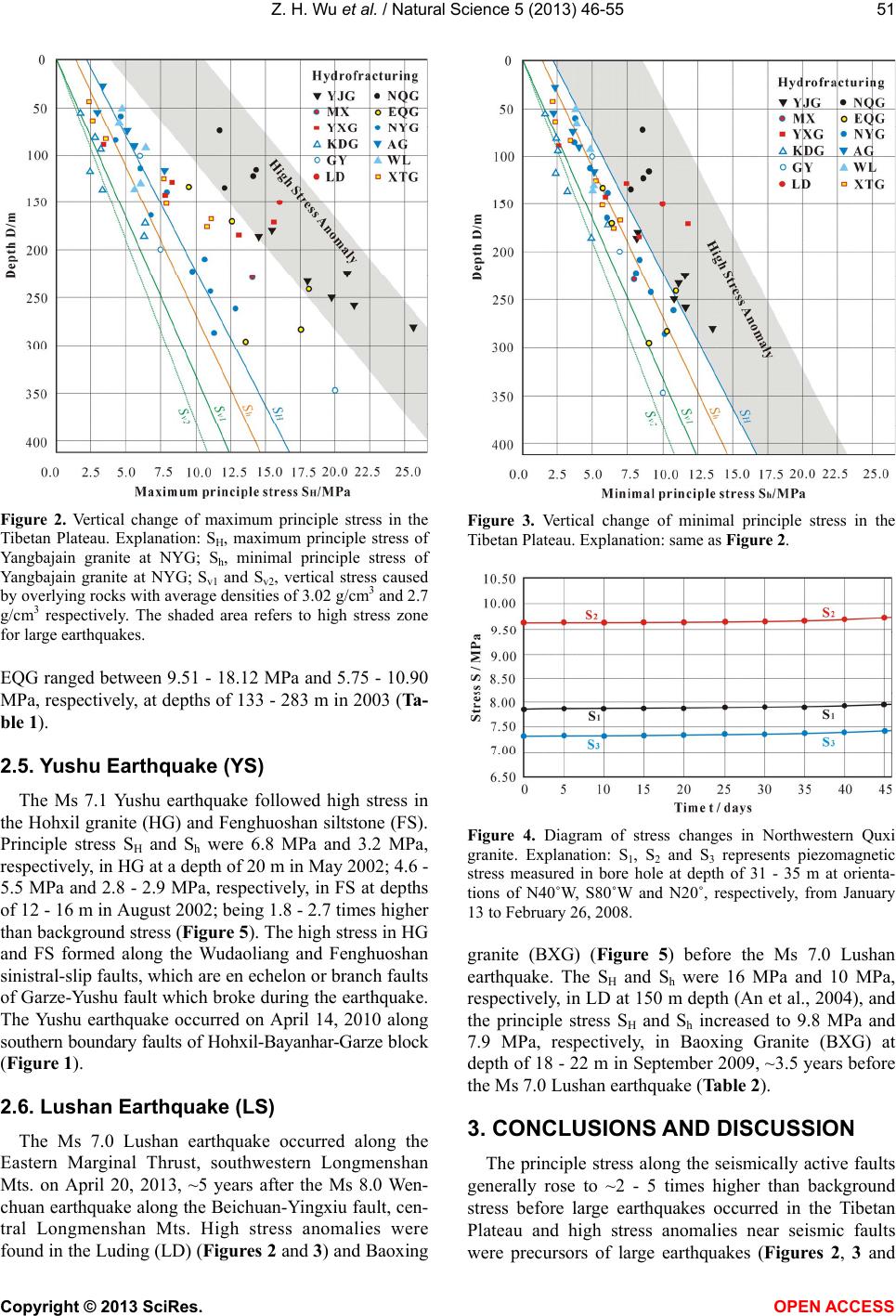 Z. H. Wu et al. / Natural Science 5 (2013) 46-55 51 Figure 2. Vertical change of maximum principle stress in the Tibetan Plateau. Explanation: SH, maximum principle stress of Yangbajain granite at NYG; Sh, minimal principle stress of Yangbajain granite at NYG; Sv1 and Sv2, vertical stress caused by overlying rocks with average densities of 3.02 g/cm3 and 2.7 g/cm3 respectively. The shaded area refers to high stress zone for large earthquakes. EQG ranged between 9.51 - 18.12 MPa and 5.75 - 10.90 MPa, respectively, at dep ths of 133 - 283 m in 2003 ( Ta- ble 1). 2.5. Yushu Earthquake (YS) The Ms 7.1 Yushu earthquake followed high stress in the Hohxil gr anite (HG) and Fenghuoshan siltston e (FS). Principle stress SH and Sh were 6.8 MPa and 3.2 MPa, respectively, in HG at a depth of 20 m in May 2002; 4.6 - 5.5 MPa and 2.8 - 2.9 MPa, respectively, in FS at depths of 12 - 16 m in August 2002; being 1.8 - 2.7 times higher than background stress (Figure 5). The high stress in HG and FS formed along the Wudaoliang and Fenghuoshan sinistral-slip faults, which are en echelon or b ranch faults of Garze-Yushu fault which broke during the earthquake. The Yushu earthquake occurred on April 14, 2010 along southern boundary faults of Hohxil-Bayanhar-Garze block (Figure 1). 2.6. Lushan Earthquake (LS) The Ms 7.0 Lushan earthquake occurred along the Eastern Marginal Thrust, southwestern Longmenshan Mts. on April 20, 2013, ~5 years after the Ms 8.0 Wen- chuan earthquake along the Beichuan-Yingxiu fault, cen- tral Longmenshan Mts. High stress anomalies were found in the Lud ing (LD) (Figures 2 and 3) and Baoxing Figure 3. Vertical change of minimal principle stress in the Tibetan Plateau. Explanation: same as Figure 2. Figure 4. Diagram of stress changes in Northwestern Quxi granite. Explanation: S1, S2 and S3 represents piezomagnetic stress measured in bore hole at depth of 31 - 35 m at orienta- tions of N40˚W, S 80˚W and N20˚, respectively, from January 13 to February 26, 2008. granite (BXG) (Figure 5) before the Ms 7.0 Lushan earthquake. The SH and Sh were 16 MPa and 10 MPa, respectively, in LD at 150 m depth (An et al., 2004), and the principle stress SH and Sh increased to 9.8 MPa and 7.9 MPa, respectively, in Baoxing Granite (BXG) at depth of 18 - 22 m in September 2009, ~3.5 years before the Ms 7.0 Lushan earthquake (Table 2). 3. CONCLUSIONS AND DISCUSSION The principle stress along the seismically active faults generally rose to ~2 - 5 times higher than background stress before large earthquakes occurred in the Tibetan Plateau and high stress anomalies near seismic faults were precursors of large earthquakes (Figures 2, 3 and Copyright © 2013 SciRes. OPEN A CCESS 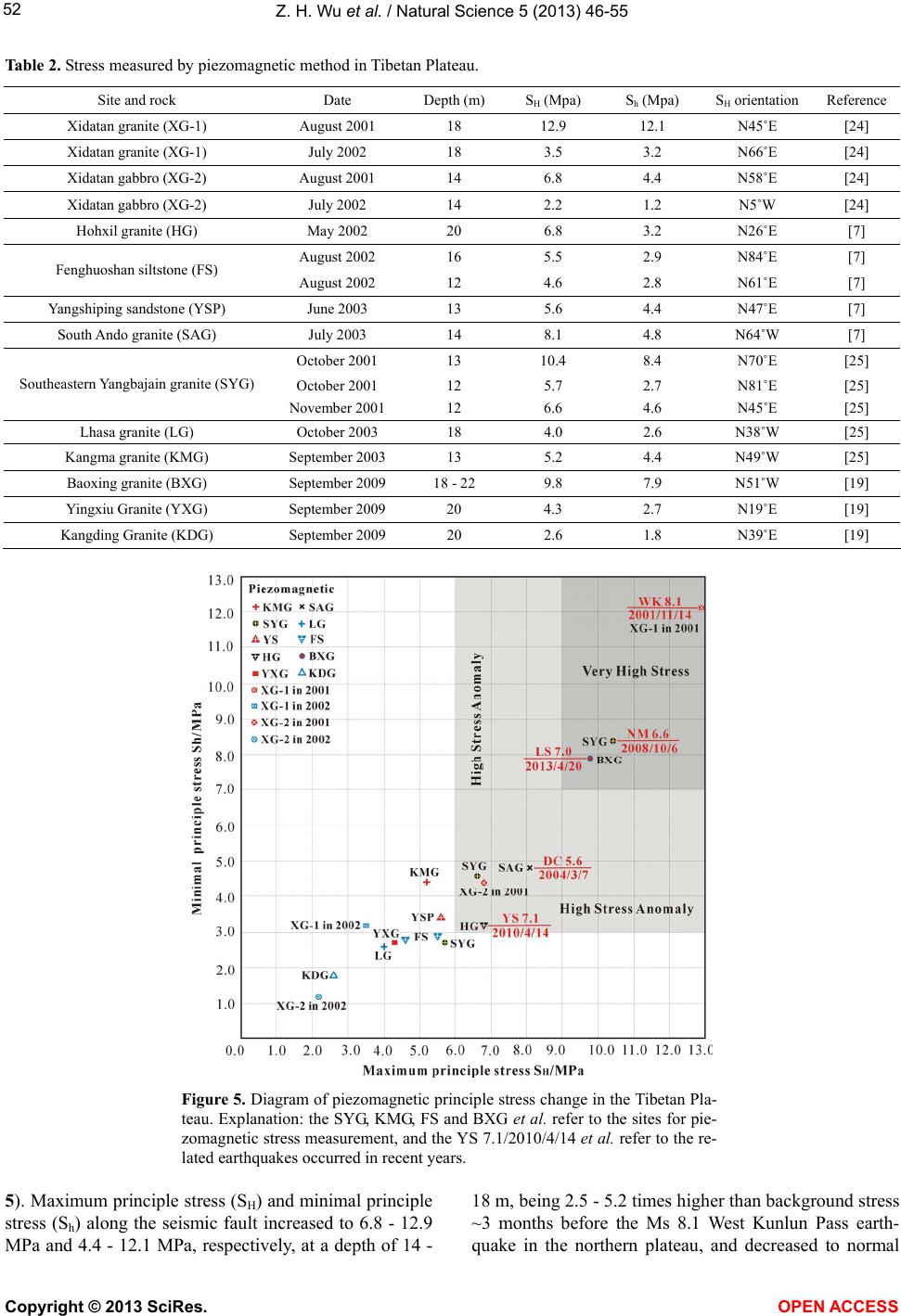 Z. H. Wu et al. / Natural Science 5 (2013) 46-55 Copyright © 2013 SciRes. 52 Table 2. Stress measured by piezomagnetic method in Tibetan Plateau. Site and rock Date Depth (m) SH (Mpa) Sh (Mpa) SH orientation Reference Xidatan granite (XG-1) August 2001 18 12.9 12.1 N45˚E [24] Xidatan granite (XG-1) July 2002 18 3.5 3.2 N66˚E [24] Xidatan gabbro (XG-2) August 2001 14 6.8 4.4 N58˚E [24] Xidatan gabbro (XG-2) July 2002 14 2.2 1.2 N5˚W [24] Hohxil granite (HG) May 2002 20 6.8 3.2 N26˚E [7] August 2002 16 5.5 2.9 N84˚E [7] Fenghuoshan siltstone (FS) August 2002 12 4.6 2.8 N61˚E [7] Yangshiping sandstone (YSP) June 2003 13 5.6 4.4 N47˚E [7] South Ando granite (SAG) July 2003 14 8.1 4.8 N64˚W [7] October 2001 13 10.4 8.4 N70˚E [25] October 2001 12 5.7 2.7 N81˚E [25] Southeastern Yangbajain granite (SYG) November 2001 12 6.6 4.6 N45˚E [25] Lhasa granite (LG) October 2003 18 4.0 2.6 N38˚W [25] Kangma granite (KMG) September 2003 13 5.2 4.4 N49˚W [25] Baoxing granite (BXG) September 2009 18 - 22 9.8 7.9 N51˚W [19] Yingxiu Granite (YXG) September 2009 20 4.3 2.7 N19˚E [19] Kangding Granite (KDG) Septe mber 2009 20 2.6 1.8 N39˚E [19] Figure 5. Diagram of piezomagnetic principle stress change in the Tibetan Pla- teau. Explanation: the SYG, KMG, FS and BXG et al. refer to the sites fo r pie- zomagnetic stress measurement, and the YS 7.1/2010/4/14 et al. refer to the re- lated earthquakes occurred in recent years. 5). Maximum principle stress (SH) and minimal principle stress (Sh) along the seismic fault increased to 6.8 - 12.9 MPa and 4.4 - 12.1 MPa, respectively, at a depth of 14 - 18 m, being 2.5 - 5.2 times higher than background stress ~3 months before the Ms 8.1 West Kunlun Pass earth- quake in the northern plateau, and decreased to normal OPEN A CCESS  Z. H. Wu et al. / Natural Science 5 (2013) 46-55 53 stress state ~8 months after the earthquake (Table 2). The SH and Sh in Yaoji granite on eastward thrust sheet in- creased to 14.44 - 25.53 MPa at depths of 180.3 - 280.5 m before the Ms 8.0 Wenchuan earthquake, being ~2 times higher than background stress, and recovered to a normal stress state one year after the earthquake in Longmenshan Mountains at the eastern margin of the Tibetan Plateau (Figures 2 and 3). The SH and Sh in- creased to 9.8 MPa and 7.9 MPa, respectively, in BXG at depth of 18 - 22 m, and 16 MPa and 10 MPa, respec- tively, in LD at 150 m depth before the Ms 7.0 Lushan earthquake. The principle stress SH and Sh increased to 2.2 - 4.2 times higher than background stress before the Ms 6.6 Nimu earthquake; stress in 3 orientations rapidly increased 0.10 - 0.12 MPa within 45 days near seismic epicenter ~8 months before the Nimu earthquake in the southern Tibetan Plateau (Figure 4). A high stress anom- aly also formed in Fenghuoshan (FS) and Hohxil (HG) along seismic faults before the Ms 7.1 Yushu earthquake occurred in April 2010. Additional high stresses were also found in the Yan- shiping sandstone (YSP) where the SH and Sh were 5.6 MPa and 4.4 MPa, respectively, at a depth of 13 m in June 2003, and in th e Kangma Gr anite (KMG) where th e SH and Sh were 5.2 MPa and 4.4 MPa, respectively, at a depth 13m (Table 2). If the maximum stress SH continues to increase as much as 0.5 - 1.0 MPa in the related areas, then the YSP and KMG will be plotted in the high stress anomaly in SH-Sh diagram (Figure 5). This high stress anomaly could be connected with some Ms 6.0 - 7.0 earthquake in the near future. Significantly different types of fault zones show the stress increase even though they might be compressional or extensional structures. The West Kunlun Pass and Yu- shu earthquakes were due to strike-slip offset, the Wen- chuan earthquake was due to oblique-slip thrust offset, the Lushan earthquake was due to thrust offset and the Nimu and Dongco earthquakes were due to normal fault offset. Thus, the fault type makes no obvious difference in the development of stress anomalies prior to an earth- quake. Stress variations relative to rock mechanic changes [26] and tectonic divisions [6], local stress from non-tectonic processes as permafrost freezing [27] and ancient residual stress [10] might cause local stress anomalies, but these factors rarely lead to regional stress anomalies along active faults and result in regular stress changes before and after large earthquakes. Apparently deep barriers acting as friction decrease slip rates or even stop slip along active faults and in- crease stress along the blocked segments of active faults, leading to high stress anomalies before large earthquakes (Figures 2, 3 and 5). This is a reflection of the strain build up near faults as proposed by Reid [2], but the re- sulting stress seems more restricted and the buildup is more rapid than what might be expected. These charac- teristics aid in using high stress anomalies in the upper crust surface as viable precursors for prediction of large earthquakes within continents, such as the Tibetan Pla- teau. Other indices as Coulomb failure stress on faults [28,29], tectonic stress and stress variations inferred from numerical modeling [12,30-32], and hydrochemistry anomalies [33] also have been suggested in forecasting earthquakes, but none are as sensitive to earthquakes as the in-situ measured stress in the Tibetan Plateau. The GPS measurements indicated low slip rates of active faults and low velocity of terrains in the Longmenshan Mountains [15], where the Wenchuan earthquake oc- curred, and no high velocity or strain anomalies were discovered by GPS measurements before the Ms 8.0 Wenchuan earthquake, the Ms 8.1 West Kunlun Pass earthquake, the Ms 6.6 Nimu earthquake, the Ms 7.1 Yushu earthquake and the Ms 7.0 Lushan earthquake in the Tibetan Plateau, implying that GPS measurements are not nearly as effective as in-situ stress measurements for earthquake prediction. Using stress to monitor earth- quakes appears a practical approach for forecasting large continental earth quakes. 4. ACKNOWLEDGEMENTS This research was supported by the Ministry of Land and Resources of China under grant No. 201211095 and China Geological Survey under grant Nos. 1212011120185 and 1212011221111. Thanks to the Tibetan Bureau of Geology and Mineral Resources for their help in field drilling, and thanks to the expert who reviewed the manuscript. REFERENCES [1] Wu, Z.H., Barosh, Patrick, J., Zhang, Z.C. and Liao, H.J. (2012) Effects from the Wenchuan Earthquake and seis- mic hazard in the Longmenshan Mountains at the eastern margin of the Tibetan Plateau. Engineering Geology, 143- 144, 28-36. doi:10.1016/j.enggeo.2012.06. 006 [2] Reid, H.F. (1910) Mechanics of the earthquake, the Cali- fornia Earthquake of April 18, 1906. Report of the State Investigation Commission, Carnegie Institution of Wash- ington, Washing ton DC. [3] Li, S.-G. (1974) Earthquake geology. Science Press, Bei- jing. [4] Li, F.Q. (2010) In-situ stress measurement is an important approach to realize earthquake prediction—Developing J.S. Lee’s scientific ideas on earthquake prediction. In: Xue and Furen, Eds., Rock Stress and Earthquakes, CRC Press, Taylor and Francis Group, London, 757-759. [5] Chen, Q.X. (1998) Analysis of rock mechanics and tec- tonic stress field. Geology Publishing House, Beijing. [6] Yao, R., Yang, S.X., Lu, Y.Z., Cui, X.F., Chen, Q. and Mi, Q. (2010) Characteristics of tectonic stress in the east of Tibetan Plateau and its neighboring region inferred from Copyright © 2013 SciRes. OPEN A CCESS 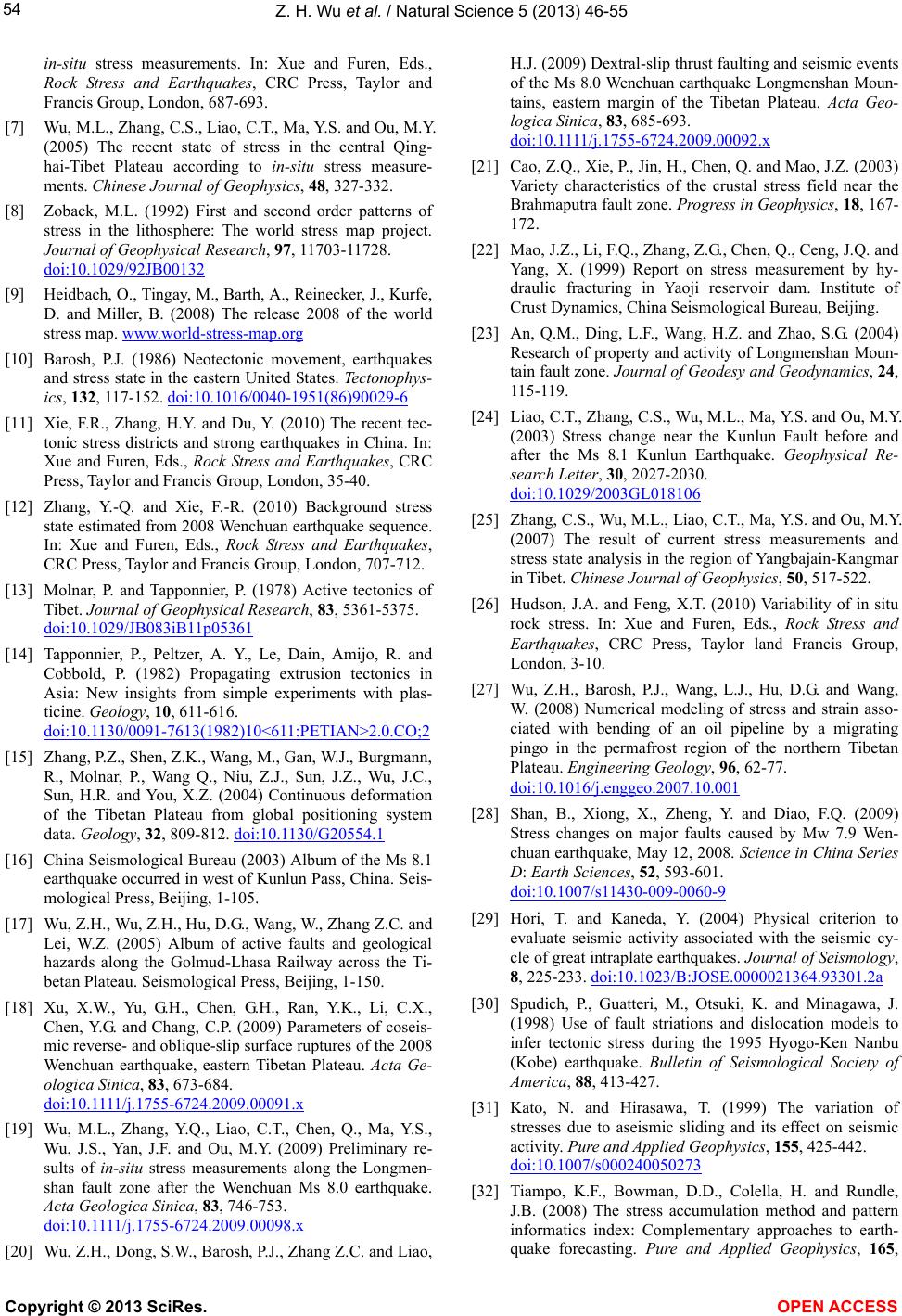 Z. H. Wu et al. / Natural Science 5 (2013) 46-55 54 in-situ stress measurements. In: Xue and Furen, Eds., Rock Stress and Earthquakes, CRC Press, Taylor and Francis Group, London, 687-693. [7] Wu, M.L., Zhang, C.S., Liao, C.T., Ma, Y.S. and Ou, M.Y. (2005) The recent state of stress in the central Qing- hai-Tibet Plateau according to in-situ stress measure- ments. Chinese Journal of Geophysics, 48, 327-332. [8] Zoback, M.L. (1992) First and second order patterns of stress in the lithosphere: The world stress map project. Journal of Geophysical Research, 97, 11703-11728. doi:10.1029/92JB00132 [9] Heidbach, O., Tingay, M., Barth, A., Reinecker, J., Kurfe, D. and Miller, B. (2008) The release 2008 of the world stress map. www.world-stress-map.org [10] Barosh, P.J. (1986) Neotectonic movement, earthquakes and stress state in the eastern United States. Tectonophys- ics, 132, 117-152. doi:10.1016/0040-1951(86)90029-6 [11] Xie, F.R., Zhang, H.Y. and Du, Y. (2010) The recent tec- tonic stress districts and strong earthquakes in China. In: Xue and Furen, Eds., Rock Stress and Earthquakes, CRC Press, Taylor and Francis Group, London, 35-40. [12] Zhang, Y.-Q. and Xie, F.-R. (2010) Background stress state estimated from 2008 Wench uan earthquake sequence. In: Xue and Furen, Eds., Rock Stress and Earthquakes, CRC Press, Taylor and Francis Group, London, 707-712. [13] Molnar, P. and Tapponnier, P. (1978) Active tectonics of Tibet. Journal of Geophysical Research, 83, 5361-5375. doi:10.1029/JB083iB11p05361 [14] Tapponnier, P., Peltzer, A. Y., Le, Dain, Amijo, R. and Cobbold, P. (1982) Propagating extrusion tectonics in Asia: New insights from simple experiments with plas- ticine. Geology, 10, 611-616. doi:10.1130/0091-7613(1982)10<611:PETIAN>2.0.CO;2 [15] Zhang, P.Z., Shen, Z.K., Wang, M., Gan, W.J., Burgmann, R., Molnar, P., Wang Q., Niu, Z.J., Sun, J.Z., Wu, J.C., Sun, H.R. and You, X.Z. (2004) Continuous deformation of the Tibetan Plateau from global positioning system data. Geology, 32, 809-812. doi:10.1130/G20554.1 [16] China Seismological Bureau (2003) Album of the Ms 8.1 earthquake occurred in west of Kunlun Pass, China. Seis- mological Press, Beijing, 1-105. [17] Wu, Z.H., Wu, Z.H., Hu, D.G., Wang, W., Zhang Z.C. and Lei, W.Z. (2005) Album of active faults and geological hazards along the Golmud-Lhasa Railway across the Ti- betan Plateau. Seismological Press, Beijing, 1-150. [18] Xu, X.W., Yu, G.H., Chen, G.H., Ran, Y.K., Li, C.X., Chen, Y.G. and Chang, C.P. (2009) Parameters of coseis- mic reverse- and oblique-slip surface ruptures of the 2008 Wenchuan earthquake, eastern Tibetan Plateau. Acta Ge- ologica Sinica, 83, 673-684. doi:10.1111/j.1755-6724.2009.00091.x [19] Wu, M.L., Zhang, Y.Q., Liao, C.T., Chen, Q., Ma, Y.S., Wu, J.S., Yan, J.F. and Ou, M.Y. (2009) Preliminary re- sults of in-situ stress measurements along the Longmen- shan fault zone after the Wenchuan Ms 8.0 earthquake. Acta Geologica Sinica, 83, 746-753. doi:10.1111/j.1755-6724.2009.00098.x [20] Wu, Z.H., Dong, S.W., Barosh, P.J., Zhang Z.C. and Liao, H.J. (2009) Dextral-slip thrust faulting and seismic events of the Ms 8.0 Wenchuan earthquake Longmenshan Moun- tains, eastern margin of the Tibetan Plateau. Acta Geo- logica Sinica, 83, 685-693. doi:10.1111/j.1755-6724.2009.00092.x [21] Cao, Z.Q., Xie, P., Jin, H., Chen, Q. and Mao, J.Z. (2003) Variety characteristics of the crustal stress field near the Brahmaputra fault zone. Progress in Geophysics, 18, 167- 172. [22] Mao, J.Z., Li, F.Q., Zhang, Z.G., Chen, Q., Ceng, J.Q. and Yang, X. (1999) Report on stress measurement by hy- draulic fracturing in Yaoji reservoir dam. Institute of Crust Dynamics, China Seismological Bureau, Beijing. [23] An, Q.M., Ding, L.F., Wang, H.Z. and Zhao, S.G. (2004) Research of property and activity of Longmenshan Moun- tain fault zone. Journal of Geodesy and Geodynamics, 24, 115-119. [24] Liao, C.T., Zha ng, C.S., Wu, M.L., Ma, Y.S. and Ou, M.Y. (2003) Stress change near the Kunlun Fault before and after the Ms 8.1 Kunlun Earthquake. Geophysical Re- search Letter, 30, 2027-2030. doi:10.1029/2003GL018106 [25] Zhang, C.S., Wu, M.L., Liao, C.T., Ma, Y.S. and Ou, M.Y. (2007) The result of current stress measurements and stress state analysis in the region of Yangbajain-Kangmar in T ibet. Chinese Journal of Geophysics, 50, 517-522. [26] Hudson, J.A. and Feng, X.T. (2010) Variability of in situ rock stress. In: Xue and Furen, Eds., Rock Stress and Earthquakes, CRC Press, Taylor land Francis Group, London, 3-10. [27] Wu, Z.H., Barosh, P.J., Wang, L.J., Hu, D.G. and Wang, W. (2008) Numerical modeling of stress and strain asso- ciated with bending of an oil pipeline by a migrating pingo in the permafrost region of the northern Tibetan Plateau. Engineering Geology, 96, 62-77. doi:10.1016/j.enggeo.2007.10.001 [28] Shan, B., Xiong, X., Zheng, Y. and Diao, F.Q. (2009) Stress changes on major faults caused by Mw 7.9 Wen- chuan earthquake, May 12, 2008. Science in China Series D: Earth Sciences, 52, 593-601. doi:10.1007/s11430-009-0060-9 [29] Hori, T. and Kaneda, Y. (2004) Physical criterion to evaluate seismic activity associated with the seismic cy- cle of great intraplate earthquakes. Journal of Seismology, 8, 225-233. doi:10.1023/B:JOSE.0000021364.93301.2a [30] Spudich, P., Guatteri, M., Otsuki, K. and Minagawa, J. (1998) Use of fault striations and dislocation models to infer tectonic stress during the 1995 Hyogo-Ken Nanbu (Kobe) earthquake. Bulletin of Seismological Society of America, 88, 413-427. [31] Kato, N. and Hirasawa, T. (1999) The variation of stresses due to aseismic sliding and its effect on seismic activity. Pure and Applied Geophysics, 155, 425-442. doi:10.1007/s000240050273 [32] Tiampo, K.F., Bowman, D.D., Colella, H. and Rundle, J.B. (2008) The stress accumulation method and pattern informatics index: Complementary approaches to earth- quake forecasting. Pure and Applied Geophysics, 165, Copyright © 2013 SciRes. OPEN A CCESS  Z. H. Wu et al. / Natural Science 5 (2013) 46-55 Copyright © 2013 SciRes. OPEN A CCESS 55 693-709. doi:10.1007/s00024-008-0329-5 [33] Harmann, J. and Levy, K.J. (2006) The influence of seismotectonics on precursory changes in underground- water composition for the 1995 Kobe earthquake, Japan. Hydrogeology Journal, 4, 1307-1318. doi:10.1007/s10040-006-0030-7
|